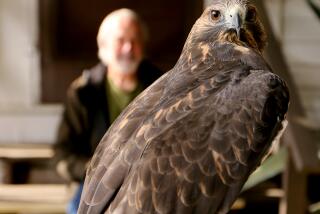U.S. probes golden eagles’ deaths at DWP wind farm
- Share via
Two more golden eagles have been found dead at the Los Angeles Department of Water and Power wind farm in the Tehachapi Mountains, for a total of eight carcasses of the federally protected raptors found at the site.
The U.S. Fish and Wildlife Service is trying to determine the cause of death of the two golden eagles found Sunday at the Pine Tree wind farm, about 100 miles north of Los Angeles and 15 miles northeast of Mojave, said Lois Grunwald, a spokeswoman for the agency.
The agency has determined that the six golden eagles found dead earlier at the 2-year-old wind farm in Kern County were struck by blades from some of the 90 turbines spread across 8,000 acres at the site.
Those deaths give Pine Tree one of the highest avian mortality rates in California’s wind farm industry. The death rate per turbine at the $425-million facility is three times higher than at California’s Altamont Pass Wind Resource Area, where about 67 golden eagles die each year. However, the Altamont Pass facility has 5,000 wind turbines — 55 times as many as Pine Tree.
The flight behavior and size of golden eagles make it difficult for them to maneuver through forests of wind turbine blades spinning as fast as 200 mph — especially when the birds are distracted by the sight of squirrels and other prey. Golden Eagles are about 40 inches tall and weigh about 14 pounds,
The DWP is developing a avian and bat protection plan that “will include measures for mitigating risks to golden eagles,” utility spokesman Brooks Baker said.
Critics say the problem is fundamental. “The increasing golden eagle mortality at Pine Tree clearly points to wind turbines built in the wrong location,” said Ileene Anderson, a biologist with the Center for Biological Diversity. The utility needs to redesign its 250-megawatt Pine Tree network and Kern County needs to put a moratorium on construction of nearby wind farms to prevent deaths, Anderson said.
Garry George, renewable energy project director for Audubon California, said the best solution is to devote years of research into golden eagles’ behavior in an area before deciding where to erect turbines. “If you don’t ... you wind up with a Pine Tree,” George said.
Killing golden eagles is illegal under federal law, but so far, federal authorities have not prosecuted any wind farm operators for violations.
A prosecution in the Pine Tree case could force the booming alternative energy industry to revise its approach at a time when Kern County is drafting boundary maps for wind resource areas for dozens of proposed wind projects designed to generate electricity for Los Angeles County.
A year ago, the Kern County Board of Supervisors adopted a renewable energy goal of having 10,000 megawatts of renewable energy production by 2015. Los Angeles has a renewable energy goal of 35% by 2020.
A coalition of environmental groups including the Sierra Club, the Center for Biological Diversity and the Defenders of Wildlife recently sued Kern County to block construction of the proposed North Sky River and Jawbone wind energy projects, which would operate on 13,535 acres of mountainous terrain adjacent to Pine Tree.
According to the lawsuit, the projects would have an unacceptable effect on protected bat and avian species, including the golden eagle and the rare and protected California condor, and on an important avian migratory corridor.
More to Read
Sign up for Essential California
The most important California stories and recommendations in your inbox every morning.
You may occasionally receive promotional content from the Los Angeles Times.











